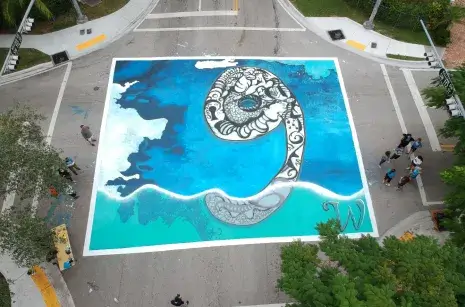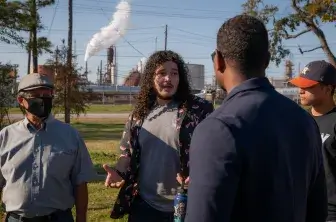Strategy 2: Engage and Educate
Empower Diverse Messengers

Building a stronger coalition for climate action requires a greater diversity of people who are aware of and committed to action. Trusted messengers can help because they communicate through values, beliefs, faiths, or other identities they share with their communities.
More recommendations
The United States comprises a host of diverse communities based on location, political affiliation, race, socioeconomic status, faith, and other identities—and these communities tend to view climate issues in dramatically different ways. For example, communities that live close to coastlines may associate climate change with observable coastal erosion, while inland communities may worry about climate-related flooding.[i] Communities engage most effectively with climate issues that reflect their values, such as the protection of public health, conservation, or being a good steward for creation. Communicating well not only helps reach broader audiences but strengthens social cohesion, which improves mental health and better prepares communities to adapt and build resilience.
Communicating climate change has historically been done by scientists and experts who some communities perceive as elite and respond poorly to. For this reason, empowering messengers and trusted leaders from various communities can be more persuasive, especially for reaching skeptical populations. For example, advertising campaigns from New Climate Voices, a group of conservatives focused on effecting climate action by appealing to economic growth, national security, and other issues typically prioritized by conservatives, have successfully increased Republican understanding of climate change.[ii]
Encouraging scientists to emphasize other parts of their identities also facilitates effective communication. For example, the group Science Moms puts a spotlight on climate scientists who are also mothers.[iii] Communicating about climate issues by emphasizing concern for children’s well-being frames the issue in a way that engages and motivates mothers.
Research has also shown that the most effective communication does not come from sharing scientific knowledge, but through messages targeting emotion, morality, and the human spirit.[iv] Art, music, and poetry help people understand climate change, connect with the issue emotionally, and take action. For example, the Miami-based CLEO Institute (Climate Leadership Engagement Opportunities) created sculptures of iconic Florida symbols that melted in temperatures above ninety degrees, raising awareness of the impact extreme heat will have on quality of life in the state.
Framing climate issues in personally relevant and less abstract ways also makes it easier to engage diverse communities. Finding the messengers that resonate with audiences is key to successful messaging. For example, the Hip Hop Caucus uses the visibility of popular musical artists to spread climate information, while the organization Good Energy consults on engaging ways to integrate climate issues in TV and film.[v] Medical professionals such as nurses and physicians, who remain two of the most trusted professionals, can emphasize the extent of harmful health effects from climate change and the health benefits of many climate solutions.[vi]
Cultural context varies enormously and has a significant impact on communication. For example, the Indochinese Cultural and Service Center considered intergenerational knowledge transfer while communicating with their community about climate issues. Because elders in many Asian/Pacific Islander communities are more likely to listen to their grandchildren than their adult children, they focused on educating the youth on climate issues to spread climate information most effectively throughout the entire community.[vii]
Many of these examples have been funded by philanthropy. For philanthropists seeking to make an impact on climate change, supporting these authentic messengers is a highly effective way to spend resources.
[i] Brian Kennedy, “Most Americans Say Climate Change Affects Their Local Community, Including 70% Living Near Coast,” Pew Research Center, June 29, 2020, https://www.pewresearch.org/fact-tank/2020/06/29/most-americans-say-climate-change-impacts-their-community-but-effects-vary-by-region-2/.
[ii] See New Climate Voices, https://www.newclimatevoices.org (accessed June 12, 2023); and Matthew H. Goldberg, Abel Gustafson, Seth A. Rosenthal, and Anthony Leiserowitz, “Shifting Republican Views on Climate Change through Targeted Advertising,” Nature Climate Change 11 (7) (2021), https://doi.org/10.1038/s41558-021-01070-1.
[iii] See Science Moms, https://sciencemoms.com/; and Potential Energy Coalition, https://potentialenergycoalition.org/.
[iv] Amy E. Lesen, Ama Rogan, and Michael J. Blum, “Science Communication through Art: Objectives, Challenges, and Outcomes,” Trends in Ecology and Evolution 31 (9) (2016): 657–660.
[v] For more on the Hip Hop Caucus, see https://hiphopcaucus.org/. For more on Good Energy, see https://www.goodenergystories.com/.
[vi] Kathleen Gaines, “Nursing Ranked as the Most Trusted Profession for 21st Year in a Row,” nurse.org, January 25, 2023, https://nurse.org/articles/nursing-ranked-most-honest-profession/.
[vii] U.S. Environmental Protection Agency, Case Studies from the Environmental Justice Collaborative Problem-Solving Program: Models for Success (Washington, D.C.: U.S. Environmental Protection Agency, 2008), https://nepis.epa.gov/Exe/ZyPDF.cgi/60000QOK.PDF?Dockey=60000QOK.PDF.






